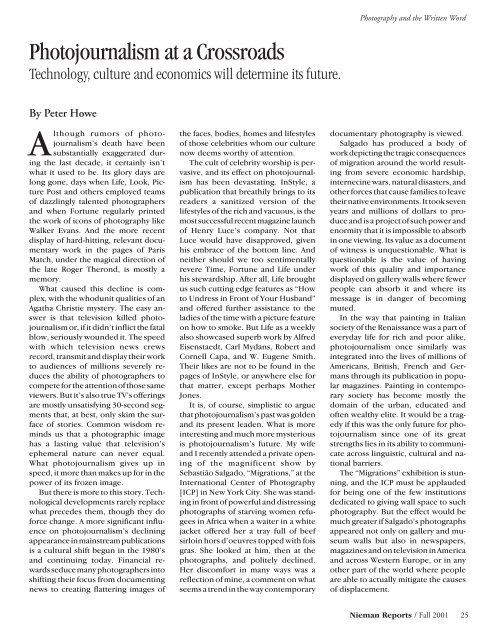Download - Nieman Foundation - Harvard University
Download - Nieman Foundation - Harvard University
Download - Nieman Foundation - Harvard University
You also want an ePaper? Increase the reach of your titles
YUMPU automatically turns print PDFs into web optimized ePapers that Google loves.
Photography and the Written WordPhotojournalism at a CrossroadsTechnology, culture and economics will determine its future.By Peter HoweAlthough rumors of photojournalism’sdeath have beensubstantially exaggerated duringthe last decade, it certainly isn’twhat it used to be. Its glory days arelong gone, days when Life, Look, PicturePost and others employed teamsof dazzlingly talented photographersand when Fortune regularly printedthe work of icons of photography likeWalker Evans. And the more recentdisplay of hard-hitting, relevant documentarywork in the pages of ParisMatch, under the magical direction ofthe late Roger Therond, is mostly amemory.What caused this decline is complex,with the whodunit qualities of anAgatha Christie mystery. The easy answeris that television killed photojournalismor, if it didn’t inflict the fatalblow, seriously wounded it. The speedwith which television news crewsrecord, transmit and display their workto audiences of millions severely reducesthe ability of photographers tocompete for the attention of those sameviewers. But it’s also true TV’s offeringsare mostly unsatisfying 30-second segmentsthat, at best, only skim the surfaceof stories. Common wisdom remindsus that a photographic imagehas a lasting value that television’sephemeral nature can never equal.What photojournalism gives up inspeed, it more than makes up for in thepower of its frozen image.But there is more to this story. Technologicaldevelopments rarely replacewhat precedes them, though they doforce change. A more significant influenceon photojournalism’s decliningappearance in mainstream publicationsis a cultural shift begun in the 1980’sand continuing today. Financial rewardsseduce many photographers intoshifting their focus from documentingnews to creating flattering images ofthe faces, bodies, homes and lifestylesof those celebrities whom our culturenow deems worthy of attention.The cult of celebrity worship is pervasive,and its effect on photojournalismhas been devastating. InStyle, apublication that breathily brings to itsreaders a sanitized version of thelifestyles of the rich and vacuous, is themost successful recent magazine launchof Henry Luce’s company. Not thatLuce would have disapproved, givenhis embrace of the bottom line. Andneither should we too sentimentallyrevere Time, Fortune and Life underhis stewardship. After all, Life broughtus such cutting edge features as “Howto Undress in Front of Your Husband”and offered further assistance to theladies of the time with a picture featureon how to smoke. But Life as a weeklyalso showcased superb work by AlfredEisenstaedt, Carl Mydans, Robert andCornell Capa, and W. Eugene Smith.Their likes are not to be found in thepages of InStyle, or anywhere else forthat matter, except perhaps MotherJones.It is, of course, simplistic to arguethat photojournalism’s past was goldenand its present leaden. What is moreinteresting and much more mysteriousis photojournalism’s future. My wifeand I recently attended a private openingof the magnificent show bySebastião Salgado, “Migrations,” at theInternational Center of Photography[ICP] in New York City. She was standingin front of powerful and distressingphotographs of starving women refugeesin Africa when a waiter in a whitejacket offered her a tray full of beefsirloin hors d’oeuvres topped with foisgras. She looked at him, then at thephotographs, and politely declined.Her discomfort in many ways was areflection of mine, a comment on whatseems a trend in the way contemporarydocumentary photography is viewed.Salgado has produced a body ofwork depicting the tragic consequencesof migration around the world resultingfrom severe economic hardship,internecine wars, natural disasters, andother forces that cause families to leavetheir native environments. It took sevenyears and millions of dollars to produceand is a project of such power andenormity that it is impossible to absorbin one viewing. Its value as a documentof witness is unquestionable. What isquestionable is the value of havingwork of this quality and importancedisplayed on gallery walls where fewerpeople can absorb it and where itsmessage is in danger of becomingmuted.In the way that painting in Italiansociety of the Renaissance was a part ofeveryday life for rich and poor alike,photojournalism once similarly wasintegrated into the lives of millions ofAmericans, British, French and Germansthrough its publication in popularmagazines. Painting in contemporarysociety has become mostly thedomain of the urban, educated andoften wealthy elite. It would be a tragedyif this was the only future for photojournalismsince one of its greatstrengths lies in its ability to communicateacross linguistic, cultural and nationalbarriers.The “Migrations” exhibition is stunning,and the ICP must be applaudedfor being one of the few institutionsdedicated to giving wall space to suchphotography. But the effect would bemuch greater if Salgado’s photographsappeared not only on gallery and museumwalls but also in newspapers,magazines and on television in Americaand across Western Europe, or in anyother part of the world where peopleare able to actually mitigate the causesof displacement.<strong>Nieman</strong> Reports / Fall 2001 25
















